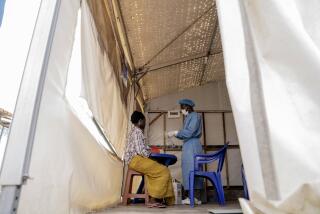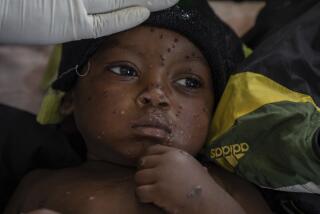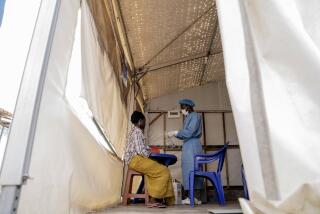Smallpox Vaccine Recommended for Exposure to Monkeypox
- Share via
As the number of monkeypox cases climbed from 48 to 63 Wednesday, federal health authorities expanded their investigation of the outbreak into another 12 states and recommended that anyone who might have come in contact with infected pet prairie dogs be immunized with the smallpox vaccine.
Meanwhile, the Department of Health and Human Services banned the sale of prairie dogs within the United States and placed an embargo on the import of rodents from Africa -- such as the Gambian giant rat that is believed to have infected the prairie dogs -- in an effort to stave off further infections.
After weighing risks posed by exposure to monkeypox against risks associated with the smallpox vaccination, the Centers for Disease Control and Prevention elected to make the vaccine its method of choice to control the spread of the disease.
The vaccine is estimated to protect 85% of those who receive it after exposure to monkeypox. It will be given on a case-by-case basis to those who have handled an infected pet or who have visited a pet store, veterinary clinic or pet distributor where ill animals have been identified. They can be vaccinated up to 14 days after exposure to the virus.
“We need to be prepared for the fact that monkeypox can be a fatal disease,” said Dr. David Fleming, deputy director of the CDC, at a news briefing Wednesday.
“We are recommending smallpox vaccine for a limited number of people. We feel the risk is sufficient to warrant recommending it, [even] for pregnant women and children.”
Fleming said he was “confident everything that can be done is being done to prevent the spread of this disease.” He urged the owners of prairie dogs to watch their animals and contact a veterinarian if they display symptoms of the disease: runny nose, oozing eyes and a rash.
Fleming stressed that the pets should not be released into the wild, destroyed or disposed of by pet owners.
The disease has been confirmed in nine people, and as many as 54 other suspected cases have been reported in Wisconsin, Illinois, Indiana, and, most recently, New Jersey -- the first indication that the disease might have spread outside the Midwest. All the reported cases are believed to have originated through contact with infected prairie dogs or, in one case, an infected rabbit. The New Jersey boy with symptoms was exposed on a visit to the Midwest.
State and federal investigators are searching 15 states for prairie dogs distributed to pet brokers and pet shops by Phil’s Pocket Pets of Villa Park, Ill. The prairie dogs are thought to have been infected by a Gambian giant rat that was part of a shipment of 50 rats brought in by a Texas distributor.
Monkeypox, which normally occurs only in central and western Africa, has a death rate as high as 10%, though that statistic might be prove to be lower in the United States. So far, no deaths have been reported here.
Symptoms of the disease include fever, headache, chills, body aches and a rash. Contact with the pus-filled blisters that accompany the rash is believed to be the main method of human-to-human transmission, but Fleming said there have been no documented instances of such transmission in the United States.
More to Read
Sign up for Essential California
The most important California stories and recommendations in your inbox every morning.
You may occasionally receive promotional content from the Los Angeles Times.













